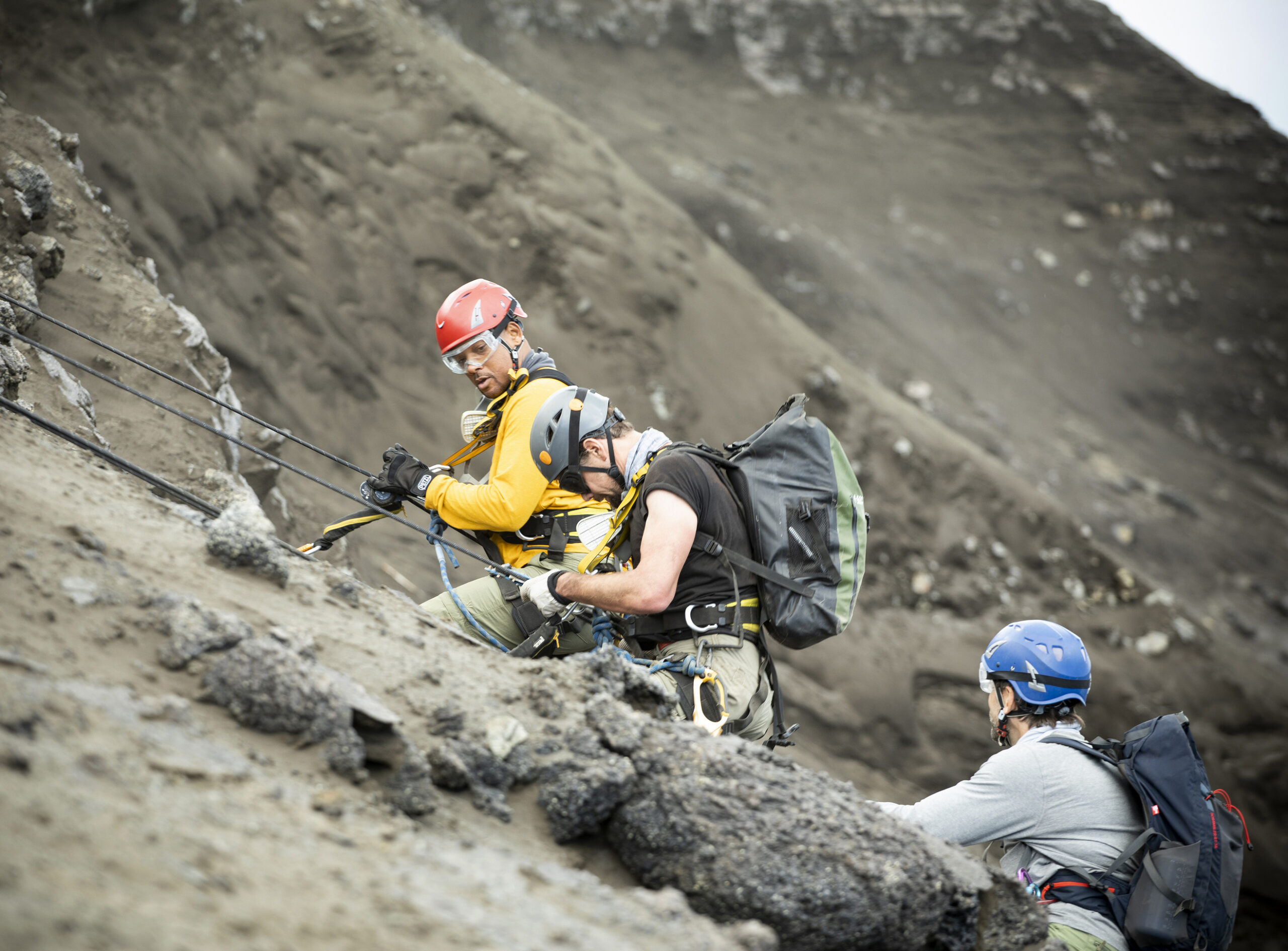It’s not often you get to step inside a volcano or experience true silence, but with “Welcome to Earth” you can do exactly that — alongside Will Smith.
It might seem humans have mapped every inch of our planet’s surface, but look closer and you’ll discover that there is still so much more to uncover — the age of exploration is far from over.
Welcome to Earth, a Disney+ original series from National Geographic, follows two-time Academy Award® nominee Will Smith on a fascinating adventure around the world to explore Earth’s greatest wonders and reveal its most hidden secrets. Throughout the six-part limited series produced by visionary Academy Award-nominated filmmaker Darren Aronofsky, Protozoa Pictures, Jane Root’s Nutopia, and Westbrook Studios, Will is guided by elite explorers on an awe-inspiring journey. He gets up close and personal with some of the most thrilling spectacles on the planet — from volcanoes that roar in silence to deserts that move beyond our perception to animal swarms with minds of their own.
Combining breathtaking cinematography with Will’s boundless curiosity and enthusiasm, the blockbuster series is an exciting, multisensory ride through Earth’s most mind-bending portals.
The show is a fantastic watch, especially if you can watch it in 4K or better. Visually, “Welcome to Earth” is stunning. It allows you to see the world through a completely different set of eyes.
And with none.
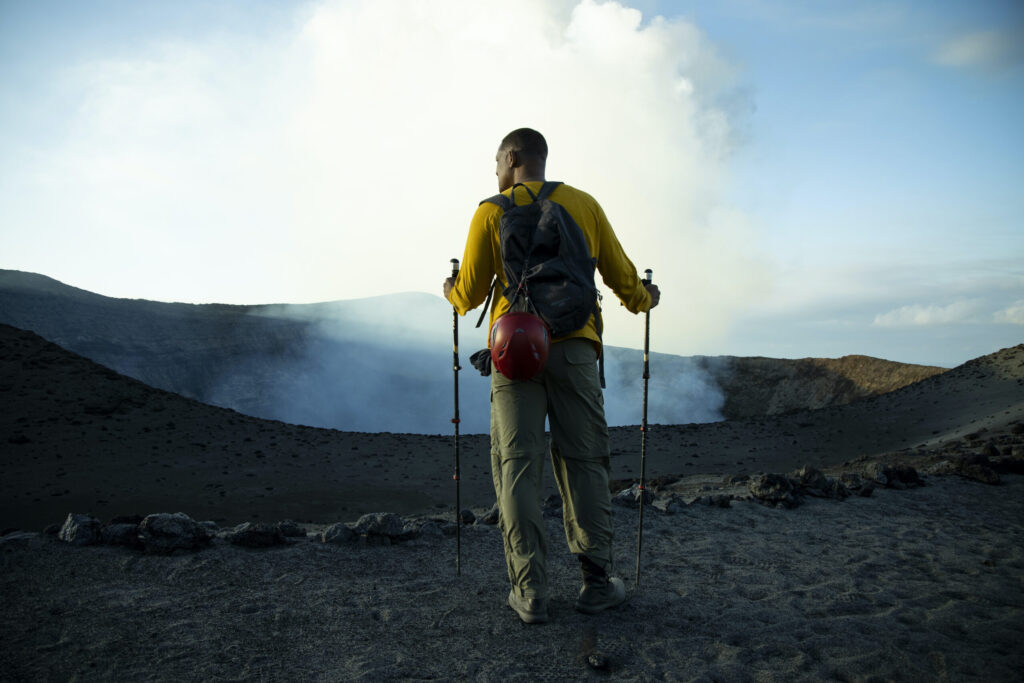
We had the opportunity to sit down with famed mountaineer and explorer, Erik Weihenmayer to discuss the show. He has climbed all seven summits and accomplished feats most of us can only dream of — only he did it without his sight.
Innovation & Tech Today: Watching you go down in the volcano in your episode of Welcome to Earth was impressive for all of you, frankly. You mentioned though, using echolocation and how you create a picture in your mind. How did you learn that?
Erik Weihenmayer: Well, when you go blind, I went off to a rehabilitation center called the Carroll Center for the Blind, and we worked a little bit on mobility there as blind kids. And they would say things like, well, “Hey, when you walk down a hallway, you can hear are the sound vibrations bouncing off of the wall,” and now when you pass this open door, you can hear that the sound changes like now the sound is moving a little further and bouncing off in the room. So, you can tell the difference between a closed door and an open door. Anyway, so I started the basics, but really then I met Daniel Kish, who was a blind guy. He’s a mobility instructor. So, he teaches blind people how to travel and be independent. And he’s a big echo locator. He’s brought it to this insane level.
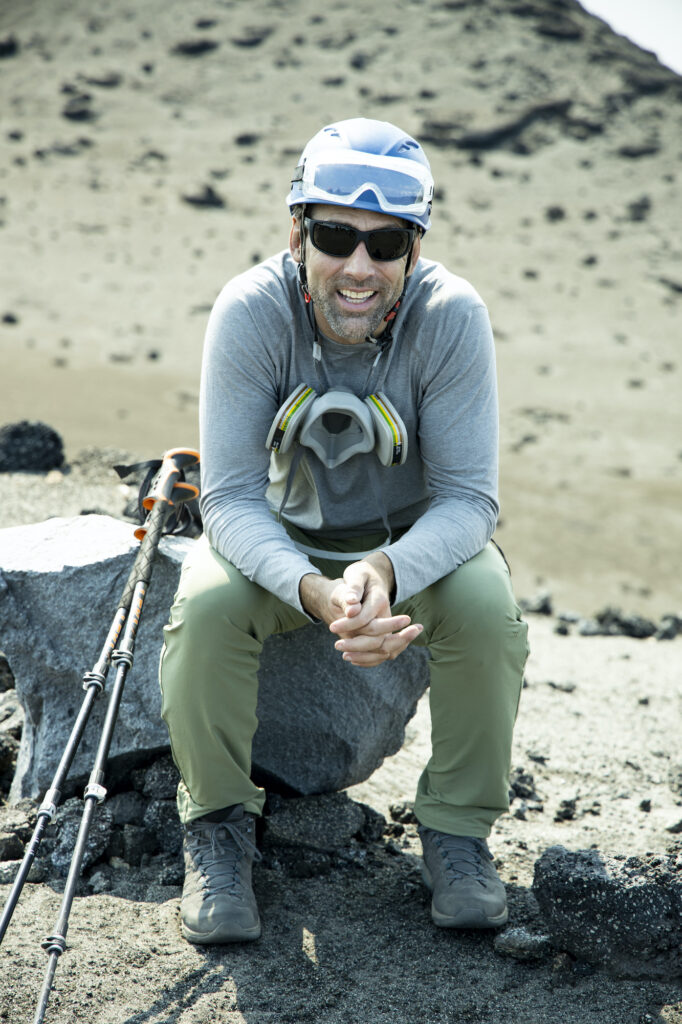
He calls it flash sonar. And so, he’s actively clicking with his tongue, but you could do it with a cane tap or something, any crisp noise, you click, and then you listen to these sound vibrations bouncing off of the various objects. And so, I walked around for three days with Daniel, and by the end, I could hear a sign or I could hear a tree because when sound vibrations bounce into a tree, it sounds a little more muffled and open than like a rock or a wall or a car.
When you click at a car, you can hear the shape of the car, like the top of the car. You can tell, is that a car or is that a van or is that a truck. You’re getting really good clues of stuff as you’re clicking away. So, yeah. I use it in the outdoors, to hear the drop-offs, to hear the boulders, to hear the rock faces, I’ll use it in canyons when I’m kayaking. So, yeah, it’s a pretty helpful tool for a blind person.
I&TT: I bet it is. Another thing I was left wondering is, what’s it like taking a celebrity along on a journey, like say inside of a volcano?
EW: Well, I’ve had experience taking a lot of people on different experiences. I founded this organization called No Barriers, and we take injured veterans climbing. We climb mountains with blind kids and people with disabilities and people in wheelchairs. I climbed a 20,000-foot peak with some veterans a few years ago. I know I’ve done dozens of those programs. So, I guess I’m used to taking people on adventures and introducing them to things, and Will was like really gung-ho. he was really excited about it, and I know that was his impetus for the…I think that was the impetus for his wanting to do the show, that he really wanted to travel and explore the world with cool people, interesting people.
I guess I’m extrapolating here, but he’d been in a ton of movies and TV shows, but he wanted to explore the world in real life, with real people. And so, he was totally gung-ho. You could tell he was a little bit nervous. We were all nervous, because you’re walking up this volcano, and there were magma bombs, the size of cars, exploding out of the vents of the volcano, and shooting like a half a mile into the sky, and they’re landing back into the volcano.
But you’re walking over volcanic rock of those magnet bombs that have fallen outside the volcano. And they’re big, every size imaginable, and it was really cool. It was like rock, but if you broke the rock in half, you could still see or feel the soft ash underneath the rock. So, it was like this newly formed volcanic rock pile that we’re walking through. You could tell the magma bomb had exploded there, when the wind was shifting or moving. So, we’re walking into this active volcano when your mind is saying, you should be running the opposite direction right now.
I&TT: That’s what my mind said while I watched.
EW: So, it was really disconcerting. We had respirators, we had ropes, we had a crew making sure the wind was not blowing in our direction, and so I thought it was like a calculated risk.
I&TT: Yeah. That makes sense. I know you joked to Will in the truck on the way up, you said, “I almost guarantee you’re going to survive.” You said it as a joke, but I imagine there is some truth to that. Those were big rocks, man.
EW: Yeah. If you want to live a totally safe life, you just hang out and watch Disney plus in your house, which I’m going to do for the show. I’m going to listen to it, but no, when you go out and you’re exploring a volcano yeah. There’s a greater risk objective hazard than hanging out on your couch.
I&TT: For sure.
EW: Although, I guess if you hung out on your couch for 10 years straight, you’d probably die of a heart attack. So, maybe it’s a wash. I don’t know.
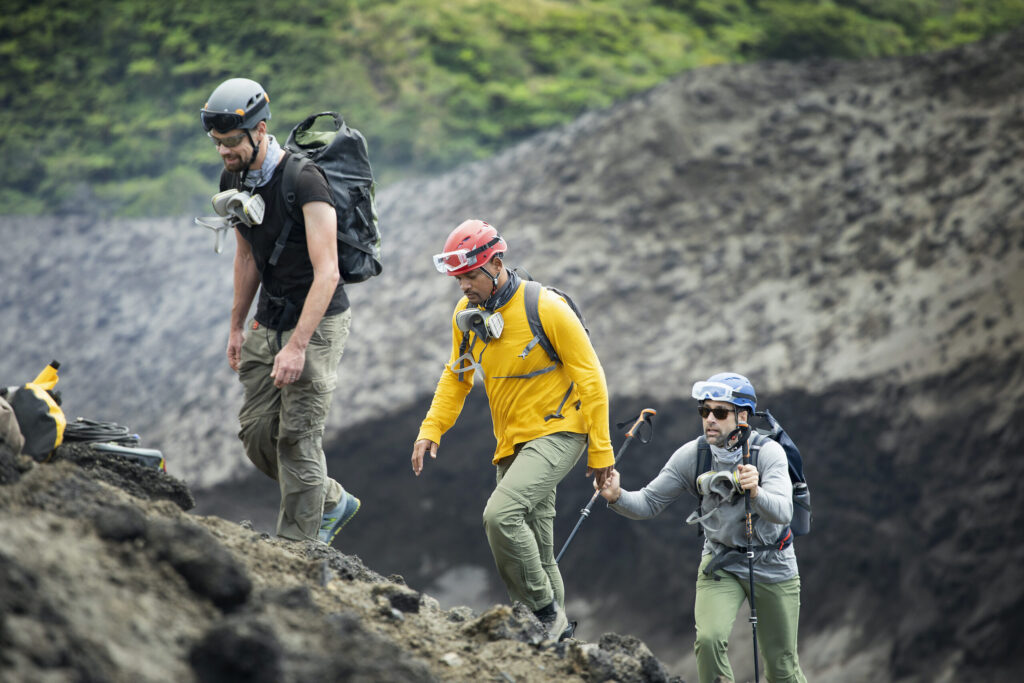
I&TT: It may be.
EW: So yeah, going out into the world can be scary. Not just the objective hazards, but the perceived danger and the perceived risk in your mind, the mind can … we have the amygdala, which is like the fight or flight part of the brain. And so, a lot of times you get in those situations and your brain’s like, what am I doing here? I’d much rather be eating a cheeseburger down in town. So, again, the show was very, very safe. You know what I mean?
And that’s my theory of adventure, too. I’m not a risk-taker, an adrenaline junkie. I’m very careful — very methodical. I have a great team around me all the time. You build up a lot of tech redundancy in the plan. So, if one thing goes wrong, you have a plan B and a plan C, so you’re minimizing risk. You’re not trying to throw yourself in danger and hope to live through it. That’s unsustainable. So, the show did a great job making sure that, we were as safe as possible.
I&TT: That’s good. Will said just being around you, he even forgot you were blind, unless you’d ask him to describe something. What kinds of challenges or advantages does being a mountaineer without sight create for you?
EW: Well, I guess it makes you unique. Like what we teach at our No Barriers organization with the folks who have lost legs and have all kinds of challenges, everything under the sun. We say, Hey, eventually you’re going to find a place for that challenge and you’re going to make it into a strength. Take your story, take the challenges, the things that you’ve fought through, the barriers you’ve broken through, the things you’ve struggled with and make them into fuel, make them into power.
I&TT: That’s great.
EW: Turn it on its head. And so, I think as a Mountaineer, I’m always trying to do that. Like what do I do well? I train really hard. I prepare really hard. I’m really fit when I get to an adventure. I’ve organized the team. I put really good people together. I put great technologies together. I’ve done some of the fundraising to make the trip happen.
I try to contribute to the reason why the team makes it a few feet higher up the mountain every day. When I started climbing, I told myself that I didn’t want to be like this blind guy that’s like a figurehead or something, where I’m just getting carried to the top and spiked like a football. I want to be part of the team. So, I’ve always tried to do that. And so, that’s a little tricky when you’re blind, because you’re not necessarily going to be the fastest person or the person route finding, but you can find ways to lead if you’re really thoughtful and think about, the overall big picture of what leadership means, I guess. And then there’s also just a sense of gratitude.
When I’m out there exploring a volcano or climbing a rock face or an ice face I have just gratitude. Maybe that sounds a little bit it cheezy, but when I went blind, sitting in the cafeteria at a table by myself, listening to all the excitement and laughter and food fights passing me by and just thinking, my God, I’m going to live a life in the darkness on the sidelines, never going to be in the food fights. I’m never going to be in the thick of things. And so, I had real like FOMO disease, fear of missing out.
And so, when I think about that moment where I just felt like I was in an absolute prison, partly maybe blindness had put me there, partly I put myself there, and I was just in this isolated prison constructed partly by me. I hated that feeling. So for me, when I’m out there exploring volcanoes, repelling down into volcanoes or climbing or whatever, and I’m out with a good team and people, friends — we’re laughing, maybe we’re a little bit scared, but we’re having fun. We’re joking around. And we’re experiencing “life” fully. I’m just full of gratitude.
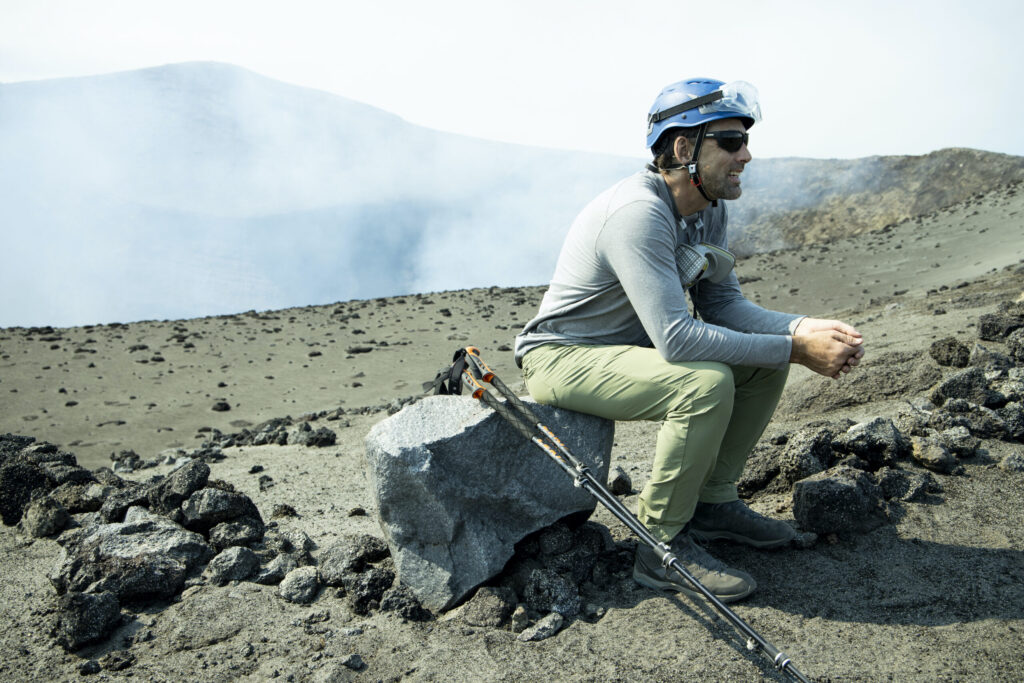
I&TT: That’s awesome.
EW: Yeah. Gratitude that I’m able to be there performing, or excelling at a high level. I don’t care if I’m the best climber, the fastest, or whatever. I’m just so grateful to be out there in the world.
I&TT: Well, in the seven summits, that’s no cakewalk for anyone.
EW: No.
I&TT: For you to have done that, means that you’ve fought and you’ve pushed. And I imagine it’s obviously more challenging than a traditional climber might deal with.
EW: Yeah, exactly. Yep. Yeah, no, I mean, there’s been times I’ve been absolutely crushed in the mountains, a thread away from passing out, or just wondering what is the limit of my mind and body, and am I getting near it?
I&TT: And sometimes feeling like it, I imagine?
EW: Sometimes you go over that line, too. Yeah. Crossing through the Khumbu, I saw the first time on Everest, I literally got to the top of the ice fall, which is a blind person’s worst nightmare. And it’s just all jumbled up boulders of ice of every size imaginable, tumbling down the mountain, like a river of ice. It is not designed for a blind person. And, I got to the top of the icefall, and I had to lay down. I had to lay down in the tent, and my friends took my crampons off my feet, and I just laid there going, “Oh my God, I just don’t know, how am I going to ever manage this?”
I&TT: And to go back down.
EW: Eventually, you wake up, and you get stronger, and you just keep going.
I&TT: Yeah. Are your family and friends pretty supportive or do they ever think you’ve lost your mind?
EW: Well, my mom passed away real tragically in a car accident when I was a teenager. So, it was just me and my dad. And my dad was always a partner to me. The typical story would be that your family would be like, “What are you crazy?” No, my dad never said that once. He always wanted me to live a fulfilled life, and not be on the sidelines. And so, my dad always was a good partner to me. He would ask me questions and make sure I was building a good team around me. And, I was doing things in a smart, logical way, but he never held me back. In fact, he always … Like when I climbed El Capitan, my dad laid in El Cap Meadows for three days as we inched our way up the rock face.
When I climbed Denali the tallest peak in North America, my dad and my family flew above us in a, I think it was a Twin Otter or something like that, watching us take our last step onto the summit. We had timed it with our base camp manager, where they radioed out to this small airstrip near the mountain where my family was waiting and we were on the top. They were flying above us and we were waving our ski poles at the plane and cheering.
In fact, it’s kind of a funny story. I said to my friend, Jeff, I said, “Hey, do you think that they’ll know I’m here? That I made it?” And he said, “Yeah, they’re going to know. You’re the only one waving your ski pole in the wrong direction.”
I&TT: Oh my God.
EW: Yes. Good to have friends.
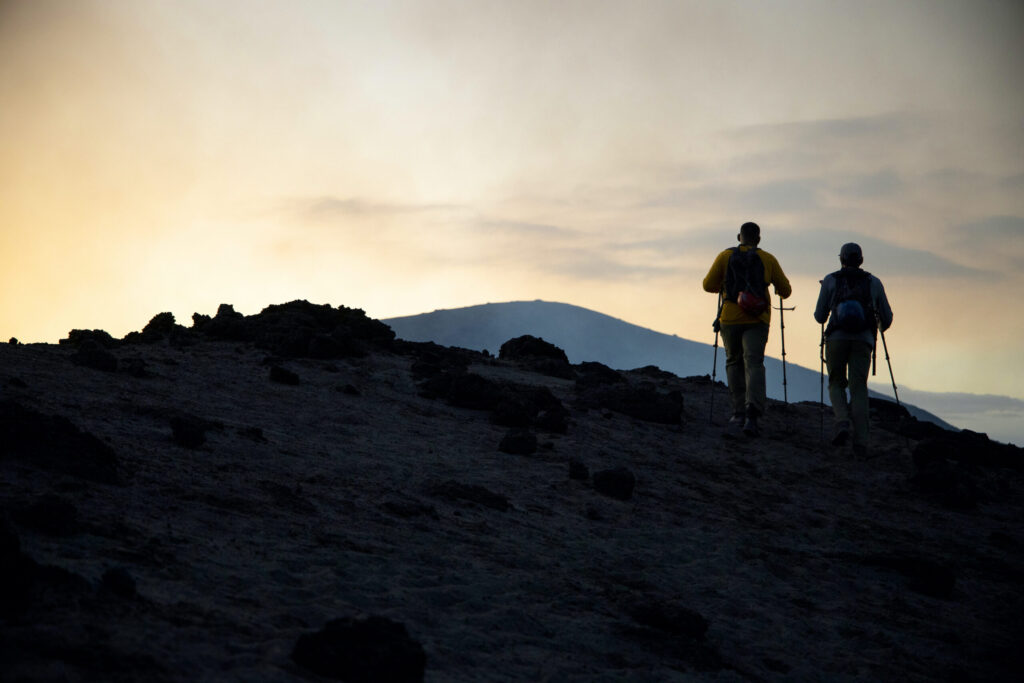
I&TT: What does it feel like to reach the top any of these mountains you’ve climbed? What’s that emotion?
EW: It’s sort of surreal. It’s sort of disbelief, because it’s a retrospective sport where you may stand on the summit, you can’t believe you’re there. You’ve worked so hard. You dreamed about this. And then you get to the summit and you got to realize the summit isn’t anything special. It’s just the top of the mountain. There’s nowhere else to go. And so, you stand there and you hug and you cheer, and you hold your flag, and you get your photos. Your mind is reeling. But then you have to come back to reality and say, “Okay, I got to get down now, 90% of accidents happen on the way down when you’re tired. And so, when you’re coming down, that’s where some of the real challenges begin, because you can not make mistakes on the way down.
Coming down, you’ve already fulfilled your goal, your quote goals. So, now you’re just trying to get down and that’s when a lot, so many people bite it or get hurt. So yeah, the summit is cool, but it’s almost like going into a church, or some kind of temple or monastery. It’s just this sacred place where humans aren’t really meant to be for that long. You go and you say your gratitude to the heavens and celebrate your potential, and what you and your team have done for just a moment. And then you turn around, you get your ass out of there.
I&TT: How has technology helped you over the years, throughout your journeys, watching it grow? I’m sure there are new tools that maybe help make it not necessarily easier, but maybe safer?
EW: Well, when I’m in the outdoors, I use technology, but it’s not very high-tech. It’s like I use trekking poles to feel my way, somebody jingles a bear bell in front of me, I would say it’s more about the systems that I’ve built. Like when I climb a frozen waterfall, I’m not looking for the blue ice. Like for a sighted person, that’s swinging their tool into the ice. I’m scanning my tool across the face and I’m tapping it very lightly against the face. And I’m listening for the sound of the ice and they’re good, sounds like a thick chunk.
And then there’s a dong or like a hitting a dinner plate. Those are sharp shattering ice in your face, plates of ice coming off, or big giant refrigerator size chunks of ice coming down, and crushing your partner, below you. So, for me, I’m delicately tapping my tool around listening for the sound. That’s the cool part that people thought you had to see the climb to do these things, but there are always other ways when you develop a system to be able to do things with your other senses, through your ears. Through your sense of touch, whatever it may be.
And I also have experimented with technologies like the BrainPort, which is a longer story where it’s a really great organization that, it’s a camera basically that takes a video image, translates to a piece of software, and projects that image onto my tongue. And so, I’m able to sense what the camera’s seeing by the pact of vibrations on my tongue. So, there are some really insane technologies out there for the blind as well.
I&TT: Wow. That’s impressive. I didn’t know that was even a thing. Where are you headed next? What’s your next journey?
EW: Well, I’m constantly leading No Barriers expeditions all over the country, all over the world. I have a trip to Alaska planned, a trip to Patagonia planned. I just got back from Scotland where I was climbing these incredible Cowes that shoot right out of the North Atlantic. Some of them you have to swim to. So, I’m always constantly doing stuff. I’m really excited about the trip. I just learned that I’m invited to, yesterday, I just literally learned about it. It’s in April and a friend of mine, a friend of a friend was a climbing guy down in Ecuador and he fell, he broke his back, he’s in a wheelchair, and he wants to be the first paraplegic to climb Cotopaxi, which is one of the tallest peaks in Ecuador.
And I would really, really like to go and support him on that adventure. I mean, that makes it really so meaningful. These things when you’re not only experiencing a beautiful mountain, but you’re supporting somebody’s dreams to do something just so outlandish.



